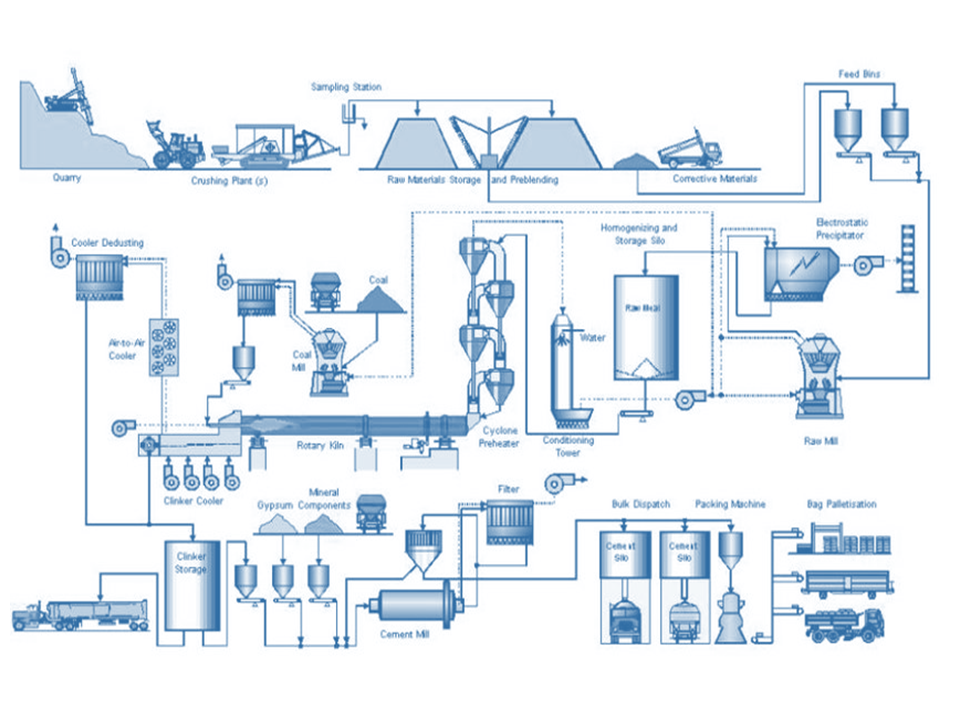The main ingredients that we need to manufacture ordinary Portland cement (OPC) are limestone, clay, and iron. These components have to be fed in the kiln (reactor) with definite composition, size, and homogeneity to achieve the desired quality of OPC. There are some simple steps that we will discuss that how OPC is being manufactured at the industrial level.
Read also: Scenerio of over pressure in process industry
Drilling and Blasting
The quarry which is a natural reserve of limestone and clay is drilled and dynamite is placed in that to convert rocks and mountains into big lumps normally 1-1.5 meters in range. The size of lumps is based on the crusher specifications hence Amount of explosive and depth of drilling can be changed as per crusher feed requirement. These lumps are shifted to the crusher through dumpers.
Crushing
Dumpers unload at a crusher hopper under which there is an apron conveyor used to take the material in front of hammers. Material crushes and passes through a 100-120mm sieve.
Stacking
As we are getting material in the form of nature reserves where there is a lot of variation in raw material so we have to stack up against our raw material in such a way that we get average chemistry. For this, we stack limestone and clay in the form of piles having chevron shapes. These piles provide us with a uniform required stock that is ready to grind.
Reclaiming
The uniformly stacked pile of raw material is scrapped via scrapper or reclaimer in a smooth ordered manner to get the average results of the pile. This raw material is then transported to limestone, clay, and iron bins under which we have dosimeter feeders to control the recipe of the raw mill.
Grinding
A vertical roller mill is a grinding unit used to reduce the size of raw material from 120mm to almost 90-100 micrometers. VRM consists of a separator, table and roller assembly, and scrapper portion. Raw material after being ground is called a raw meal.
Homogenization
The raw meal is conveyed to a control flow silo called the CF silo. CF silo is simply a weighted storage vessel equipped with heavy-duty blowers at the bottom used to homogenize the raw meal. Once the raw meal is homogenized it is then said to be kiln feed.
Preheater
The preheater consists of cyclones arranged in such a manner as to get the maximum heat out of hot gases coming from the kiln. Kiln feed is preheated in these cyclones in counterflow to hot gases. Preheated kiln feed is then introduced in pre-calciner where calcination occurs converting limestone into CaO and CO2. This results in decreasing the calcination zone in the kiln, overall kiln length, refractory reduction, and less fuel consumption at the kiln.
Kiln
Natural gas, furnace oil, coal, pet coke, rubber scrap, and rice husk can be used as fuel in a kiln to achieve a reaction temperature of 1400C in the burning zone of the kiln the point where phase formation occurs. Modulization and granulation happen there converting kiln feed into small blackish-grey balls called clinker.
Cooler
Clinker drops from the kiln to the cooler where there are fans to recuperate heat from clinker and to use these hot gases in the preheater and roller mills to optimize overall energy consumption per ton of clinker. At the end of the cooler, there is a hammer crusher or roller crusher to reduce the size of larger granules, coatings, or boulders.
Dome
Dome is a storage vessel for clinker. It is used to maintain sufficient stock for cement mill feed.
Cement Mills
Clinker is grind with 4-5% gypsum used primarily to decrease the setting time and also as a grading aid in a vertical roller mill. Clinker is ground to achieve the required fineness (Blaine) of OPC.
Cement Silo
A cement silo is a storage vessel for cement with all the necessary requirements to store and extract material for the packing plant as per dispatch.
